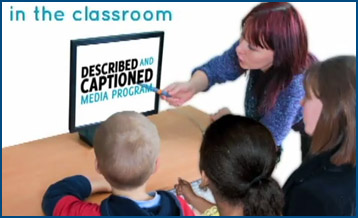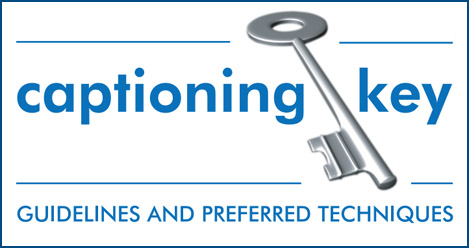<< Learning Center
Media Accessibility Information, Guidelines and Research
Five Key Reasons to Use the Described and Captioned Media Program
By Jo Ann McCann
Do you have a child in your classroom or at home who has difficulty understanding educational media because he or she is visually impaired, blind, hard of hearing, deaf, or deaf-blind? A solution is the free-loan collection of described and captioned educational media provided by the Described and Captioned Media Program (DCMP) through Individuals with Disabilities Education Act (IDEA) funding by the U.S. Department of Education.

The DCMP is also the go-to center for information about educational media access, including tips for effective use, research reports which support the need, and how-to guidelines for adding descriptions and captions to media. In addition, DCMP answers teachers' questions about equal access and helps parents advocate for their children's educational needs.
The best part is that there is no charge for any DCMP membership, products, or services! That is thanks to IDEA, which has a goal of a free and appropriate education for all children with disabilities. DCMP meshes perfectly with the IDEA pledge to ensure that educators and parents have the necessary tools to improve educational results.
The five key reasons why you should utilize this opportunity are detailed below.
Reason No. 1:
A Collection of On-Demand Accessible Educational Media
High-quality educational media with descriptions and captions is available through the DCMP. Registration is free to qualified members, including teachers, parents, and other professionals who work with a student with a vision or hearing loss.
DCMP selects media that supports academic standards and provides enrichment to curriculum for students in pre-school through Grade 12. Before any item is added to the DCMP, it is evaluated based on strict standards for technical and content quality.
Over 7,000 media titles can be viewed online or ordered for shipment to you in DVD format. Online media delivery is available via a fully-accessible media player for the web, including the ability to switch between accessibility options (captioning and description) and language options (English and Spanish). A searchable, interactive transcript feature allows for the location of specific content within a video, and supports re-watching key segments for content reinforcement. Additional viewing methods include the DCMP's channel for the Roku set-top box, and an iOS app which allows students direct access to media. Student-based viewing is supported by a comprehensive permission system, allowing teachers/parents to grant access to subject areas and/or specific titles to groups or individual students.
Reason No. 2
Provision of the Highest Quality Descriptions and Captions on All Media
Descriptions and captions are accessibility features added to videos (including those on the Internet) to provide equal access for students who are sensory impaired. Descriptions are additional segments of narration that explain or describe images to students who are blind or visually impaired, and they are inserted into pauses in a video's original soundtrack. Captions are printed transcriptions of the video's dialog or narration (along with identifying important sound effects and providing speaker identification). Captions provide access to students who are deaf or hard of hearing.
Ensuring the captions and descriptions are of high quality is of paramount importance, as this guarantees that the thousands of students who will view each DCMP media item during its lifetime will benefit from equal access. Captions and descriptions are created based on DCMP guidelines (see Reason No. 4 below), and a rigorous quality check is performed. One of the goals of the review of descriptions is to determine if the vocabulary used matches the grade level of the production. A review of captions verifies they are error free, synchronized with the audio, and displayed with enough time to be read completely.
Reason No. 3:
Information About Educational Media Access
The DCMP also serves as a clearinghouse of information on the subject of description and captioning for service to consumers, agencies, businesses, schools, and families. Offerings include numerous DCMP print and online informational resources, as well as referrals to accessibility information from the websites of DCMP consumer advocacy partners and professional groups.
Site visitors can browse or perform a keyword search for DCMP articles and webpages written by DCMP staff members, educators, advocates, and others. Information about the DCMP accessible media loan program, procedures for applying for and using the media collection, updates concerning the availability of newly available media items, research related to production and effectiveness of accessibility features, and tips for effective use of accessible media are available in the DCMP Learning Center.
The DCMP search engine not only reveals results from the DCMP website, but also from the websites of twenty other national consumer, professional, and advocacy groups. Searchers simply click on a link and are led to information on these collaborators' sites.
Reason No. 4:
One-of-a-Kind Guidelines for Creating Descriptions and Captions
Anyone wanting to create descriptions and captions for media may utilize the DCMP online guidelines which provide a framework for consistency and quality. These technical and style manuals have been used by providers, government agencies, businesses, school technology departments, teachers, parents, students, and others. They are the only such guidelines for educational media available in the United States, and have been adopted in several other countries.
The Description Key guidelines cover a range of topics from identifying what information needs to be described to determining how to describe it. Preparing educational description requires constant decision making with regard to the content and timing. The "key visual elements" of an educational program which are selected for description should be those that serve to convey a specific learning goal.

The Captioning Key includes information on language mechanics, presentation rate, sound effects, speaker identification, synchronization, and special considerations (music, dialect, slang, play on words, etc.). These guidelines have been translated into other languages, received international distribution, and have been utilized in various settings as a basic reference.
Reason No. 5:
Advocacy Regarding Media Access Issues
There are ongoing examples of lack of understanding, apathy, and prejudice that lead to inaccessibility in technology that dramatically impacts students who have sensory disabilities. Education and advocacy are crucial to overcoming these barriers.
As indicated by questions continually fielded at the DCMP, the majority of people are uninformed as to laws and regulations concerning description and captioning, the process of selecting a provider of these services, the steps necessary to perform description/captioning, and the costs of procuring these services. The DCMP is a comprehensive and trusted source for answers to questions about educational description and captioning.
Said Jason Stark, DCMP Project Director: "Equal access and opportunity for children with disabilities is the hallmark of the IDEA. Through the funding provided by the Department of Education under IDEA, the DCMP is able to respond to parents' and teachers' desire to provide learning opportunities that are more interactive, self-paced, and engaging."
Pass It On!
Be a part of enabling children with special needs to reach their potential. Share this information with your friends and colleagues!
Jo Ann McCann is OSERS Project Officer—Captioning and Video Description Projects. She is a member of CODA International (Children of Deaf Adults), a non-profit organization for adult, hearing sons and daughters of deaf parent(s).
Tags:
Please take a moment to rate this Learning Center resource by answering three short questions.
